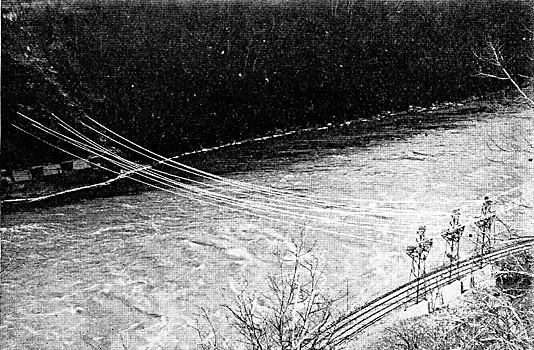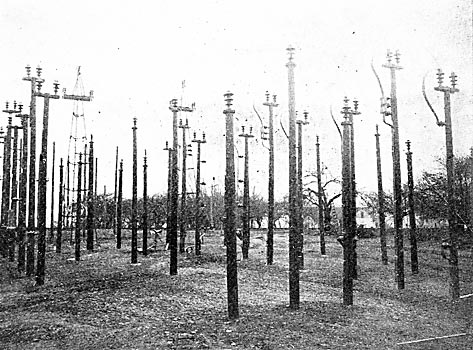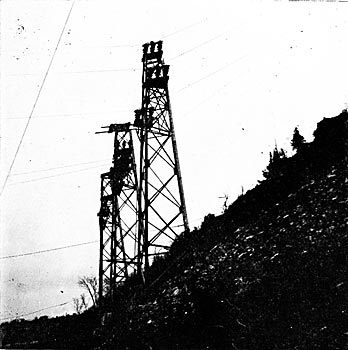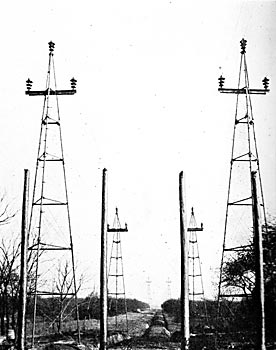[Trade Journal]
Publication: Electrical World
New York, NY, United States
vol. 42, no. 15, p. 783-784, col. 1-2
The Niagara-Syracuse Transmission Line.
BY ORRIN E. DUNLAP.
THE greatest power transmission line this side of the Rocky Mountains is being built between the Niagara border and the city of Syracuse by the Niagara, Lockport & Ontario Power Company, its length being about 160 miles. While the line has the above-mentioned length in New York State, there are also about four miles of towers and cables on the Canadian side of the river, for it is contemplated that power generated on the Canadian side shall supply the line. According to report, considerable of this transmitted Canadian Niagara energy is to be applied to the operation of present steam railroads in the western New York section, which are to be electrified. This includes portions of the New York Central and the old West Shore between the Niagara border and Syracuse, while electric roads in the cities referred to will be able to obtain power from the line if they so desire. In the map shown below transformer stations are indicated by the circles, transmission lines by the solid lines, and extensions by the broken lines.
The power house in which the electric current for transmission is to be generated is that of the Ontario Power Company. As this plant has been fully described in these pages, a mere resume here is sufficient. It is located at the water's edge in the Niagara gorge right below where famous old Table Rock used to stand. The debris slope of the river bank has been cleared away to make room for the power station, which is a concrete building that stands very close to the foot of the Horseshoe Fall. There is no other building so close to the falling waters as they plunge from the higher to the lower level, and as the demand for power increases it is the company's intention to enlarge the power house and its equipment.
 |
| Fig.1 — Map of Transmission System. |
The Ontario Power Company adopted a plan very similar to that of the Niagara Falls Hydraulic Power & Mfg. Company, the oldest power company on the New York side of the river, but instead of building a surface canal it built a great steel flume to carry the water from the forebays to the spillway over the power house. The company erected a great wing dam that diverted the water from a large area of the riverbed above the Horseshoe, and in this unwatered section it built its forebays. the intake works being located at the head of Dufferin Islands, at a deep indenture in the shore. The outer forebay has an area of eight acres, and the inner forebay an area of two acres. These ten acres of forebay area lie in the normal bed of the river, a concrete wall surrounding the outside. Considerable of the limestone riverbed had to be blasted away to give the required depth of water. The outer forebay is long and tapering and terminates at the lower end in a spillway enclosed on the river side by a submerged wall, while opposite the spillway is a screen house leading to the inner forebay. The gatehouse is located at the lower end of the inner forebay, and here electrically-operated Stoney headgates are located. The depth of water is 30 ft., and it is at this point that the big steel flume obtains its water supply.
No other feature of the power development at Niagara commanded quite so much attention as the big flume of this company. It is made of 1/2-in. riveted and reinforced steel, has a diameter of 18 ft. inside measurement, is 6,500 ft. long, and is sheeted with concrete. In order that it may not disfigure the park lands, a trench was excavated through the rock and soil of Victoria Park and the conduit buried from sight. The velocity of the water in the conduit is about 15 ft. per second. Each pipe of this kind is expected to deliver 3,900 cu. ft. of water per second, or enough to develop 60,000 electrical hp. At its end on the cliff above the power house the present flume turns into an outer relief or spillway, and it is here that the penstocks are connected.
| |||
| Fig. 2. — Aluminum Transmission Line Across Niagara Gorge. |
Eight penstocks will connect with each big flume, and six of these penstocks, or three pairs, will have a diameter of 9 ft. and carry water to the wheels of six main generators. Before delivering its water to the wheels in the power station each of the 9-ft. penstocks divides into two branches, one for each wheel. There are also two smaller penstocks that deliver water to the wheels of the exciters. Twin, turbine wheels mounted on horizontal shafts are direct-connected to the 10,000-hp generators installed in the station. Three generators have already been installed by the Westinghouse Company, and the fourth is now being erected. In passing from the spillway to the power house the penstocks run through tunnels driven through the cliff, in order that their presence may not mar the scenic spectacle at the face of the cliff. The power generated in the station will pass over concealed cables to a distributing station located on the bluff outside of Victoria Park, the distance back of the power house being 550 ft., while the height is 250 ft.
| |||
| Fig. 3. — Near Transformer House, Niagara Falls. |
In all agreements made between power companies and the commissioners of Victoria Park, it is specified that all of the power developed must be transmitted outside of the park boundaries for use and application, the agreements permitting the transmission of at least one-half of the power developed to be transmitted to the United States, but on demand one-half must be available for use in Canada at prices similar to those charged for the same power in the United States for similar uses. The Governments of the United States and the Dominion of Canada do not place an import or an export duty on electrically generated power.
From the distributing station on the bluff to the rear of Victoria Park a line of steel towers extends northward, a short distance back from the river, to a point four miles down the gorge, where the transmission line crosses the river. At the edge of the Canadian bank the cables, which are of aluminum, drop to cantilever arms projecting over the edge of the bank. There are nine cables, each having to strands of No. 5 wire, and from the cantilever arms the cables drop to steel towers erected close to the water's edge. From these towers they swing over the river, the span being about boo ft., to similar towers erected on the New York shore. Then they pass up the bank to cantilever arms at the top of the cliff on the New York side, and then to poles and steel towers.
From this point eastward to Lockport the right of way of the power transmission line is 300 ft. wide, and there is a double set of steel towers. From Lockport to Rochester the right of way has a width of 200 ft., and between Rochester and Syracuse the permanent right of way will be too ft. wide. Steel towers will carry the cables as far as Rochester, and from there to Syracuse wooden frames made in the shape of the letter A will support them, temporarily along the West Shore Railroad right of way. There will be about 1,500 steel towers and 2,500 A frames. The steel towers have a height of 55 ft., and at a height of 45 ft. there is an arm. Insulators are placed at each end of the arm and at the apex of the tower, each insulator being about 28 in. high and weighing about 75 lb. The insulators are the largest used in a Niagara transmission, and have two petticoats and a hood, the latter having a diameter of about 14 in. The steel towers are set 550 ft. apart, but the A frames will be placed 220 ft. apart. The height of the wooden frames is 49 ft.
| |||
| Fig. 4. — Steel Towers on New York Side. |
Transformer stations will he erected at various points along the line. One will be located on the river bank on the New York side, where the transmission line crosses the gorge, and another will be in Lockport. These two stations will take care of the local distribution at the points referred to. It is expected that the transmission will be made at a voltage of 60,000 right from the distributing station on the bluff over the power house. From Lockport a branch transmission line has been built to Depew and the South Buffalo district, the right of way being 200 ft. wide, and the towers having four legs, whereas the towers between Niagara Falls and Lockport have but three legs.
| |||
| Fig. 5. — General View of Transmission Line. |
In running through western New York this transmission line is being built south of one set of towns and cities and north of another section, so that it will be possible by running short branch lines to give an excellent service in either direction. The power will be applied to the operation of trolley lines, of industrial plants and for lighting purposes where needed. Between Lockport and Rochester there are many thriving places like Gasport, Middleport, Medina, Albion, Holley, Spencerport, etc., which will welcome the advent of Niagara power to their sections. It is expected that the transmission line will be ready to deliver its current some time during the coming summer, as the power house is now ready to supply the line, and the big distributing station is having its transformer equipment placed in position.
There is so much talk about the electrification of the steam railroads of New York State that the enterprise shown in the construction of this transmission line far into the interior of He State must be looked upon as possibly a part of the project of electrification. When in operation it will be the longest power transmission in the East, and its operation during the various seasons will interest engineers to a considerable extent, as it is well known that the longer transmissions in the West have a vantages in climate and weather not possessed by this Eastern work. Up to this time the longest transmission of any great amount of power from Niagara is to the city of Buffalo, the distance being about 25 miles, so that carrying Niagara power to Syracuse, about 160 miles away from the generating station, be quite a different accomplishment.




